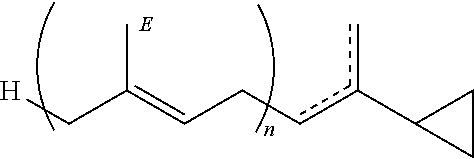Process for the cyclopropanation of olefins using N-methyl-N-nitroso compounds
a technology of cyclopropane and olefin, which is applied in the field of cyclopropane alkene, can solve the problems of poor reproducibility of reaction, hsub>3/sub>posub>4, and the yield of any desired methylenated product is reduced
- Summary
- Abstract
- Description
- Claims
- Application Information
AI Technical Summary
Benefits of technology
Problems solved by technology
Method used
Image
Examples
example 1
Preparation of (N-methyl-N-nitroso)-4-amino-4-methyl-2-pentanone (NMK) by Nitrosation in the Presence of Carboxylic Acids
[0044]
[0045]Mesityl oxide (10 g, 0.1 mol) is added dropwise over 15 min to methylamine (40% in water, 8.3 g, 0.11 mol) at 5-15° C. under external cooling and stirring. The resulting orange solution is stirred for one hour at room temperature and cooled to 10° C. where formic acid (98%, 8.4 g, 0.18 mol) is added dropwise over 15 min at 10-20° C. Then a 30% solution of sodium nitrite (8.85 g, 0.125 mol) in water (21 g) is added dropwise over 10 min at 10-15° C. The biphasic mixture is left under stirring and at room temperature overnight (16 h). After phase separation (1 h) 15.25 g (68% based on mesityl oxide) of an organic layer is obtained consisting mainly of (N-methyl-N-nitroso)-4-amino-4-methyl-2-pentanone (NMK) with a purity of 72% according to 1H-NMR with internal standard.
[0046]The following table shows results from the variation of this procedure using diff...
example 2
Preparation of (N-methyl-N-nitroso)-4-amino-4-methyl-2-pentanone (NMK) by Nitrosation in the Presence of Acetic Acid and Stronger Acids
[0048]
[0049]Mesityl oxide (10 g, 0.1 mol) is added dropwise over 15 min to methylamine (40% in water, 8.5 g, 0.11 mol) at 5-15° C. under external cooling and stirring. The resulting orange solution is stirred for one hour at room temperature and cooled to 10° C. where acetic acid (100%, 10 g, 0.1 mol) is added added dropwise over 15 min at 10-20° C. Then a 30% solution of sodium nitrite (8.85 g, 0.125 mol) in water (21 g) is added dropwise over 10 min at 10-15° C. The biphasic mixture is left under stiffing and at room temperature overnight (16 h). After phase separation (1 h) 14.25 g (62% based on mesityl oxide) of an organic layer is obtained consisting mainly of (N-methyl-N-nitroso)-4-amino-4-methyl-2-pentanone (NMK) with a purity of 70% according to 1H-NMR with internal standard.
[0050]The following table shows results from the variation of this p...
example 3
Diazomethane cyclopropanation with (N-methyl-N-nitroso)-4-amino-4-methyl-2-pentanone (NMK) Made Through Nitrosation in the Presence of HOAc
[0052]
[0053]Mesityl oxide (68.8 g, 0.7 mol) is added dropwise over 1 h to methylamine (40% in water, 58.1 g, 0.75 mol) at 5-15° C. under external cooling and stirring. The resulting orange solution is stirred for one hour at room temperature. Water (140 ml) and toluene (70 ml) are added, followed by dropwise addition of acetic acid (100%, 115 g, 1.9 mol) over 1 h at 10-20° C. Then a 30% solution of sodium nitrite (49.8 g, 0.7 mol) in water (116 g) is added dropwise over 60 min at 20-25° C. The biphasic mixture is left under stirring and at room temperature overnight (16 h). After phase separation (1 h) 155.23 g of an organic layer is obtained consisting mainly of (N-methyl-N-nitroso)-4-amino-4-methyl-2-pentanone (NMK) which is flushed with nitrogen through a sintered tube for 1 h which turns the opaque organic phase into a clear solution.
[0054]Pd...
PUM
| Property | Measurement | Unit |
|---|---|---|
| temperature | aaaaa | aaaaa |
| temperature | aaaaa | aaaaa |
| temperature | aaaaa | aaaaa |
Abstract
Description
Claims
Application Information
 Login to View More
Login to View More - R&D
- Intellectual Property
- Life Sciences
- Materials
- Tech Scout
- Unparalleled Data Quality
- Higher Quality Content
- 60% Fewer Hallucinations
Browse by: Latest US Patents, China's latest patents, Technical Efficacy Thesaurus, Application Domain, Technology Topic, Popular Technical Reports.
© 2025 PatSnap. All rights reserved.Legal|Privacy policy|Modern Slavery Act Transparency Statement|Sitemap|About US| Contact US: help@patsnap.com



